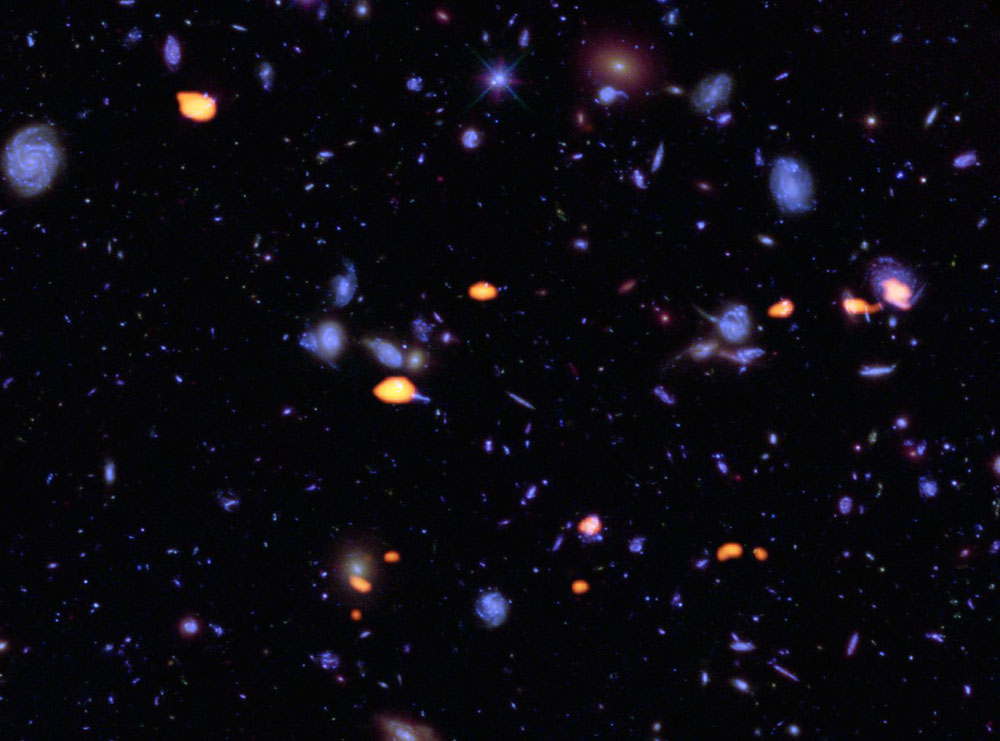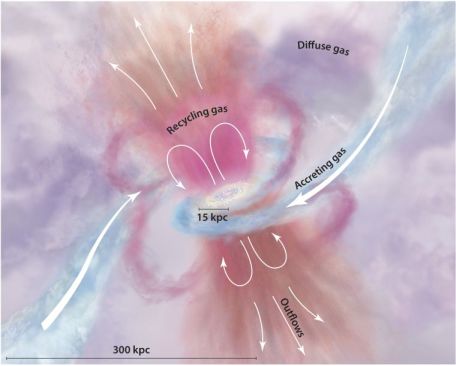Astronomers have tallied how star-making material evolved over cosmic time — and predicted how long stars will keep forming before the universe goes dark.

B. Saxton (NRAO / AUI / NSF) / ALMA (ESO / NAOJ / NRAO) / NASA / ESA Hubble
Astronomers have always been historians, looking back through time to piece together the story of the universe.
Now, they have a new primary source in hand, a historical record of molecular hydrogen gas — the stuff that makes stars. The new observations enable not only a sweeping survey of the past, but a glimpse into our cosmic future.
A History of Star Stuff
Astronomers have spent decades charting the rise and fall of galaxies’ star formation over time. The stellar baby boom occurred about 10 billion years ago, at so-called “cosmic noon.” During these early years of the universe, galaxies were bursting with newborn stars, sometimes birthing thousands per year. But rates have been falling ever since.
To explore this rise and fall, astronomers went a step earlier in the process, charting not just the stars born but the material used to make them. Molecular hydrogen gas is cool enough that hydrogen atoms pair up — and it’s also cool enough to collapse into stars. Fabian Walter (Max Planck Institute for Astronomy, Germany) and colleagues used the Atacama Large Millimeter/submillimeter Array (ALMA) to survey the Hubble Ultra Deep Field (HUDF), one of the best-studied regions of the sky. The results of that survey appear on the arXiv preprint server.
ALMA is a 66-dish array in Chile capable of spying cool gas and dust in galaxies whose light has been traveling for up to 12 billion years. “This is one of the largest programs executed at ALMA,” Walter says, adding that the program used almost 200 hours of ALMA observing time. Along with other studies of the HUDF, ALMA provided the data Walter and colleagues needed to trace the flow of gas into galaxies and into stars.
The gas that falls into galaxies is generally ionized, which means that the hydrogen atom is missing its electron. That gas has to cool, first recombining with electrons and then combining again into molecules, before it can form stars. Walter and colleagues are able to track both atomic and molecular gas to follow the flow of gas from the outermost reaches of a galaxy into its star-forming heart.
“I think we already knew that’s how it has to work, but this paper nicely quantifies, perhaps for the first time, the global rate at which that happened, averaged over all galaxies, and over most of cosmic history,” says Mark Dickinson (NSF’s NOIRLab), who was not involved in the study.

Tumlinson et al. / Annual Reviews of Astronomy & Astrophysics 2018
The observations clearly show that galaxies never, at any one point in time, hold all the gas they need to make all their stars. The gas has to come from outside — the inflow of gas necessary for star formation has continued for all observed cosmic history.
“Those are very challenging millimeter and radio measurements that were impossible not long ago,” Dickinson notes. “I think the Walter et al. paper sets an important benchmark for future analyses as new data are collected.”
The Fate of the Universe
As ever, examining the past also hints at the future. Star formation rates have declined ever since cosmic noon 10 billion years ago. The inflow of gas will only continue to decline, the researchers write: “The cosmic star formation rate density will continue its steady descent to the infinitesimal.”
It’s a one-way street, Walter says: “I cannot think of a simple way to ‘reverse’ or ‘restart’ this trend.”
The good news is that we have billions of years before the universe goes dark. And even as the influx of star-making material continues to decrease over the next 5 billion years, galaxies will continue making new stars with what they still receive. We’re hardly at the end of times just yet.
 2
2
Comments
John
October 30, 2020 at 4:58 pm
As Azimov said in The Cosmic Analog Computer: Let there be Light!
You must be logged in to post a comment.
Deryk Houston
November 26, 2020 at 2:58 pm
I can't help but think that we are only getting a glimpse of the whole picture. I thought that it was filaments that were actually powering the intense activity that we see within the galaxies inside the filaments, creating the galaxies and stars. These filaments are poorly understood at this time. I'm convinced that our interpretation of what we think we are seeing in ancient light is absolutely upside down and we are making too many extrapolations based on false beliefs or outdated ideas.
You must be logged in to post a comment.
You must be logged in to post a comment.